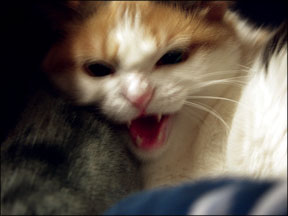Have you ever been close to a truly frightened cat? You might picture a cat peeking out from under furniture in fear of being groped by a toddler. Veterinarians of course routinely cope with cats plastered to the sides of their carriers, hanging on with all their strength. Some of us have also witnessed a cat as he suddenly puffed up, ears flattened against his head, eyes black and vocalizing in a spine tingling manner. Bev Caldwell 288 In some cases, an aggressive display may be a response to a trigger that the cat will be able to pursue. He may walk up to a large dog in his path and then pounce. This may not seem like a wise choice, but with any luck, the dog will leave. The “big cat display” may similarly enable a resident cat to send the neighbors cat back home. In these cases, there is a clear trigger, the burst of aggressive behavior makes the trigger disappear, and the cat can generally relax relatively quickly. The outcome can be very different when the cat in question cannot reach the target in order to send his urgent message effectively. Suppose your cat is contentedly watching birds and squirrels just outside the window from his cat tree when he is suddenly face-to-face with the neighbors outdoor cat. Your cats level of arousal will continue to climb until he can no longer think clearly. A calm cat could notice that there is a physical barrier in place, and he could safely cancel his message. But the highly aroused cat, unable to cross the barrier to reach the true source of danger, instead transfers his aggression to other targets. Any living creature is subject to suspicion, and anyone within reach may be attacked. The victim may be a human, feline or even canine companion. You are now experiencing the potentially dangerous condition referred to as redirected aggression. Can redirected aggression be treated? Yes, but carefully. One must always be mindful that this cat is predisposed to reacting out of proportion to the threat at hand. A frightening stimulus encountered in the future may trigger a similar aggressive response. Create Some Space The first course of action is to separate yourself from the aroused cat as quickly as possible. Excited cats respond well when stimulation is reduced to a minimum. This may be accomplished by leading the cat to a dark, quiet room. You might be able to leave a food trail to lure him along, or you might try simply blocking other pathways – do not lift an excited cat. Place a litter box, food and water in the room and do not disturb. Dont underestimate the amount of time it takes for a cat to relax. Several days may be required. Bring small meals and fresh water over the course of the day. Dont try to lure the cat over to you. If he comes over in a friendly manner, you may interact. Leave him in peace until the next meal. Once he consistently relaxes in your presence, you may begin to let him out for gradually increasing periods of time. If possible, try to reduce the potential that the original trigger for aggression will reappear. Use outdoor animal repellents or purchase blinds for the windows that offer dangerous views. Finally, you may be able to reduce your cats reaction to the stimulus through a desensitization technique. Do not begin treatment until your cat seems to be back to normal and has been reintegrated into the household. It is a bit easier to manage redirected aggression when the victim is a person. Humans may be frightened, offended or angry, but they can understand the events that led to the attack. Treatment is more challenging when the victim is another household pet. The resident cat or dog that has been attacked will be understandably frightened. He will either run away or return fire. Not only must you treat the cat who first exhibited aggression, but you will also need to address the damaged relationship among the pets. The other household pets may need treatment to reduce their own secondary fear or aggression. Do seek professional help for this most serious problem. A carefully designed behavior program will include detailed safety suggestions as well as specific techniques to reduce fear and aggression in all household pets and people. 



